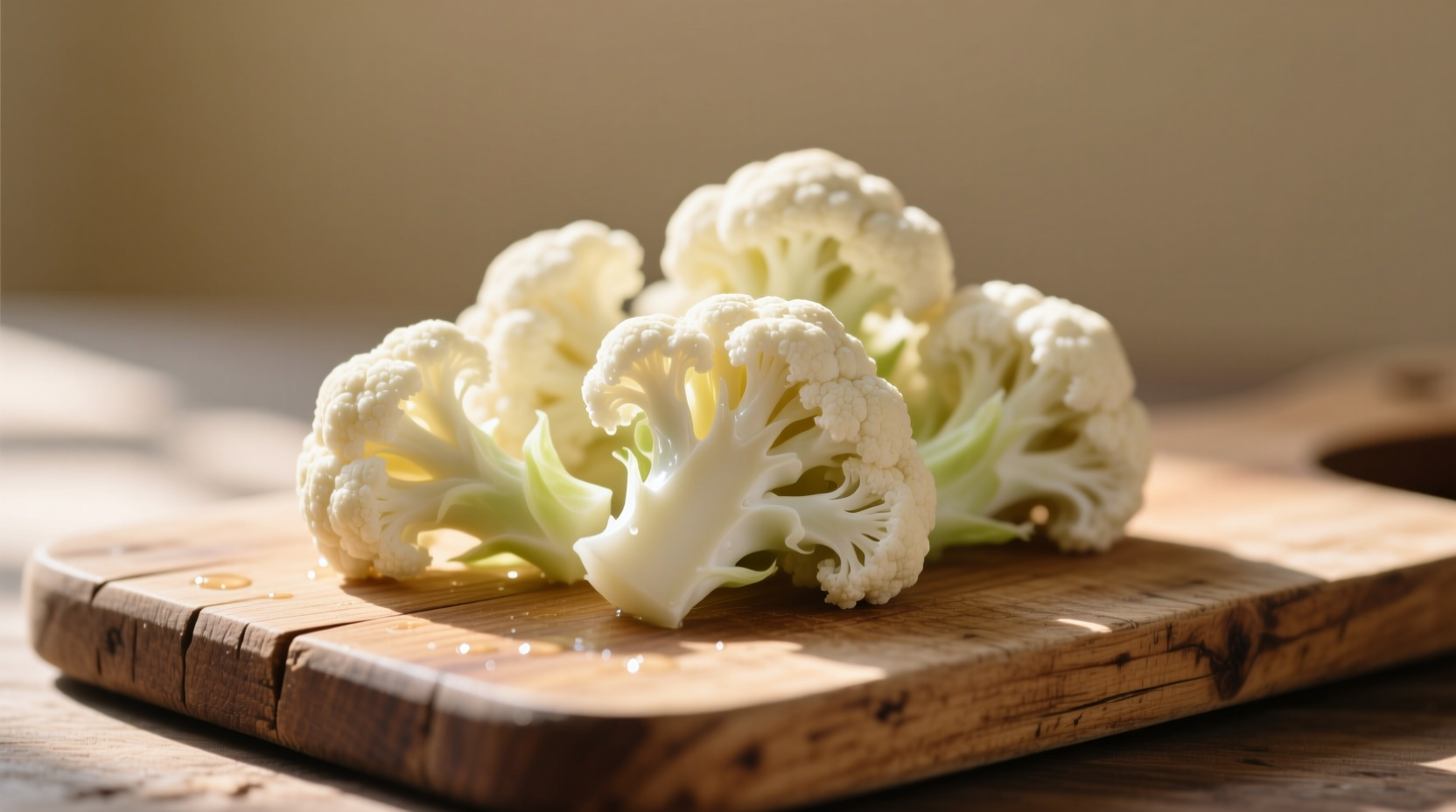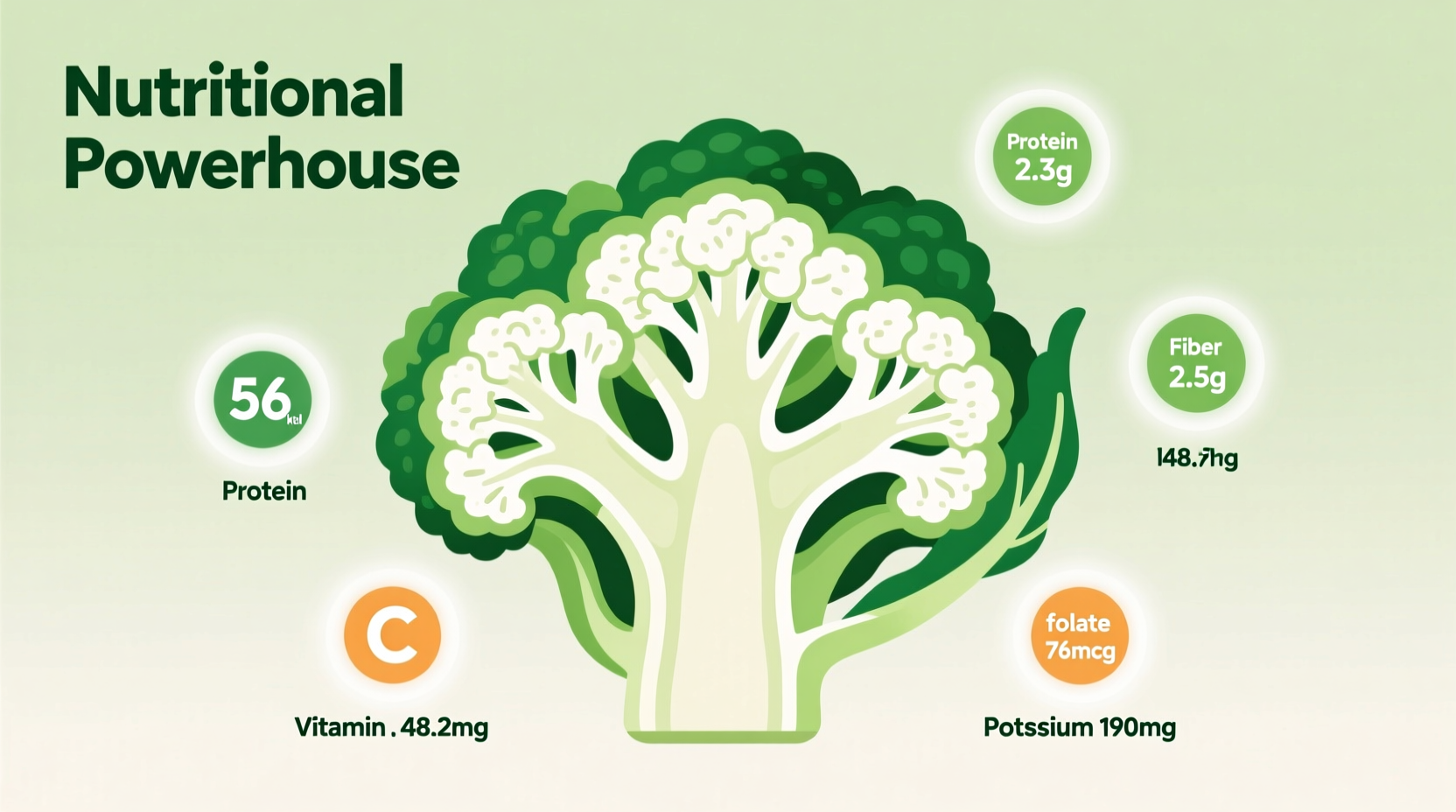Unlock Cauliflower's Complete Nutritional Power
When you reach for cauliflower at the grocery store, you're grabbing one of nature's most versatile nutritional powerhouses. This humble cruciferous vegetable delivers exceptional health benefits while adapting to countless culinary applications. Let's explore exactly what makes cauliflower a nutritional standout and how to maximize its benefits in your daily diet.
Essential Nutritional Profile: What's Inside Every Serving
Understanding cauliflower's precise nutritional composition helps you make informed dietary choices. A single cup (100g) of raw cauliflower provides:
| Nutrient | Amount per Cup (100g) | %DV* |
|---|---|---|
| Calories | 25 | 1% |
| Protein | 2g | 4% |
| Dietary Fiber | 2g | 7% |
| Vitamin C | 48.2mg | 54% |
| Vitamin K | 15.5mcg | 13% |
| Folate | 57mcg | 14% |
| Potassium | 299mg | 9% |
| Manganese | 0.15mg | 7% |
*Daily Value based on a 2,000 calorie diet (USDA FoodData Central, 2023)
Why Cauliflower Stands Out Among Vegetables
While all vegetables contribute to a healthy diet, cauliflower offers unique advantages that make it particularly valuable. Its nutritional density per calorie surpasses many common vegetables, providing substantial vitamins and minerals with minimal caloric impact.
| Nutrient Comparison per 100g | Cauliflower | Broccoli | Carrots | Spinach |
|---|---|---|---|---|
| Calories | 25 | 34 | 41 | 23 |
| Vitamin C (mg) | 48.2 | 89.2 | 5.9 | 28.1 |
| Vitamin K (mcg) | 15.5 | 101.6 | 13.2 | 482.9 |
| Folate (mcg) | 57 | 63 | 19 | 194 |
| Potassium (mg) | 299 | 316 | 320 | 558 |
Source: USDA FoodData Central, 2023
This comparison reveals cauliflower's balanced nutritional profile. While broccoli contains more vitamin C and spinach has significantly higher vitamin K, cauliflower provides an excellent middle ground with substantial amounts of multiple nutrients while remaining extremely low in calories. Its versatility in preparation methods further enhances its dietary value.
Science-Backed Health Benefits You Can Trust
Research confirms several specific health advantages associated with regular cauliflower consumption:
Cancer Prevention Properties
Cauliflower contains glucosinolates that convert to isothiocyanates like sulforaphane during chewing and digestion. According to a 2022 review published in Nutrients, these compounds demonstrate significant anti-carcinogenic effects by enhancing detoxification enzymes and reducing oxidative stress. The National Cancer Institute notes that cruciferous vegetables like cauliflower show promising associations with reduced risk of several cancer types.
Heart Health Support
The potassium content in cauliflower (299mg per cup) helps regulate blood pressure by counteracting sodium's effects. A 2021 study in the American Journal of Clinical Nutrition found that higher cruciferous vegetable intake correlated with a 16% lower risk of cardiovascular disease. The fiber content also contributes to healthy cholesterol levels.
Digestive System Benefits
With 2g of fiber per cup, cauliflower supports healthy digestion and gut microbiome diversity. Research from the Harvard T.H. Chan School of Public Health indicates that adequate fiber intake reduces the risk of digestive disorders and promotes regular bowel function. The indigestible carbohydrates in cauliflower serve as prebiotics that feed beneficial gut bacteria.
Maximizing Nutrient Retention: Cooking Methods That Preserve Value
Your preparation method significantly impacts cauliflower's nutritional value. Understanding these context boundaries helps you make informed cooking decisions:
- Raw consumption: Preserves 100% of vitamin C and heat-sensitive compounds like sulforaphane
- Steaming (5 minutes): Retains approximately 90% of vitamin C and most antioxidants (Journal of Agricultural and Food Chemistry, 2020)
- Boiling: Causes up to 60% loss of vitamin C and significant leaching of water-soluble nutrients
- Roasting: Preserves most minerals but creates beneficial antioxidant compounds through the Maillard reaction
- Microwaving: When done properly with minimal water, retains nutrients nearly as well as steaming
For maximum nutritional benefit, chop cauliflower and let it sit for 5-10 minutes before cooking. This allows the enzyme myrosinase to activate and convert glucosinolates to their active health-promoting forms.

Practical Incorporation Strategies for Daily Nutrition
Transforming cauliflower from a side dish to a nutritional powerhouse in your daily meals requires strategic planning. These evidence-based approaches help you maximize benefits:
Smart Substitutions That Boost Nutrition
Replace higher-calorie ingredients with cauliflower to increase vegetable intake without compromising satisfaction:
- Use riced cauliflower instead of white rice (1/3 the calories, triple the fiber)
- Blend steamed cauliflower into mashed potatoes (adds nutrients while maintaining texture)
- Create pizza crust from cauliflower (reduces refined carbohydrates by 50%)
- Add finely chopped cauliflower to meatloaf or burgers (increases vegetable content by 25%)
Flavor Pairing for Enhanced Nutrient Absorption
Combine cauliflower with specific ingredients to maximize nutrient uptake:
- Add healthy fats like olive oil or avocado to increase absorption of fat-soluble vitamins
- Pair with black pepper to enhance bioavailability of certain compounds
- Combine with vitamin C-rich foods like lemon juice to boost iron absorption
- Add turmeric for synergistic anti-inflammatory effects
Special Considerations for Different Dietary Needs
Cauliflower serves various dietary requirements effectively, but understanding these nuances ensures optimal benefits:
- Keto diets: With only 5g net carbs per cup, cauliflower serves as an excellent low-carb substitute
- Weight management: Its high water and fiber content promotes satiety with minimal calories
- Gluten-free needs: Provides a safe alternative for grain-based products
- Thyroid concerns: Those with thyroid conditions should consume cooked rather than raw cauliflower, as cooking reduces goitrogen content
For individuals with irritable bowel syndrome (IBS), cauliflower may trigger symptoms due to its FODMAP content. The Monash University Low FODMAP Diet guidelines recommend limiting portions to 3/4 cup cooked to minimize digestive discomfort while still gaining nutritional benefits.
Seasonal Availability and Selection Tips
Cauliflower reaches peak nutritional value during its primary growing season from October through March. When selecting cauliflower, look for:
- Firm, compact heads with clean white coloring
- Moist, green leaves (indicating freshness)
- Heavy weight for size (sign of density and nutrient concentration)
- Avoid heads with brown spots or loose curds
Store whole cauliflower heads stem-side down in the refrigerator for up to two weeks. Once cut, use within 4-5 days for maximum nutrient retention. The leaves and stems contain valuable nutrients too—don't discard them!











 浙公网安备
33010002000092号
浙公网安备
33010002000092号 浙B2-20120091-4
浙B2-20120091-4